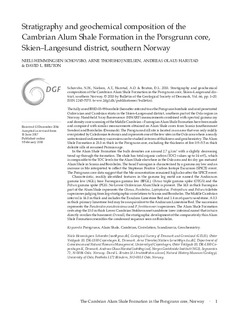| dc.description.abstract | The fully cored BHD-03-99 borehole (hereafter referred to as the Porsgrunn borehole and core) penetrated Ordovician and Cambrian strata in the Skien–Langesund district, southern part of the Oslo region in Norway. Hand-held X-ray fluorescence (HH-XRF) measurements combined with spectral gamma ray and density core scanning of the Middle Cambrian – Furongian Alum Shale Formation have been made and compared with similar measurements obtained on Alum Shale cores from Scania (southernmost Sweden) and Bornholm (Denmark). The Porsgrunn drill site is located in an area that was only mildly overprinted by Caledonian tectonics and represents one of the few sites in the Oslo area where a nearly untectonised sedimentary succession can be studied in terms of thickness and geochemistry. The Alum Shale Formation is 28.8 m thick in the Porsgrunn core, excluding the thickness of five 0.9–5.5 m thick dolerite sills of assumed Permian age. In the Alum Shale Formation the bulk densities are around 2.7 g/cm3 with a slightly decreasing trend up through the formation. The shale has total organic carbon (TOC) values up to 14 wt%, which is comparable to the TOC levels for the Alum Shale elsewhere in the Oslo area and for dry gas matured Alum Shale in Scania and Bornholm. The basal Furongian is characterised by a gamma ray low and an increase in Mo interpreted to reflect the Steptoean Positive Carbon Isotope Excursion (SPICE) event. The Porsgrunn core data suggest that the Mo concentration remained high also after the SPICE event. Characteristic, readily identified features in the gamma log motif are named the Andrarum gamma low (AGL), base Furongian gamma low (BFGL), Olenus triple gamma spike (OTGS) and the Peltura gamma spike (PGS). No Lower Ordovician Alum Shale is present. The 14.8 m thick Furongian part of the Alum Shale represents the Olenus, Parabolina, Leptoplastus, Protopeltura and Peltura trilobite superzones judging from log-stratigraphic correlations to Scania and Bornholm. The Middle Cambrian interval is 14.0 m thick and includes the Exsulans Limestone Bed and 1.4 m of quartz sandstone. A 0.3 m thick primary limestone bed may be an equivalent to the Andrarum Limestone Bed. The succession represents the Paradoxides paradoxissimus and P. forchhammeri superzones. The Alum Shale Formation rests atop the 13.0 m thick Lower Cambrian Stokkevannet sandstone (new informal name) that in turn directly overlies the basement. Overall, the stratigraphic development of the comparatively thin Alum Shale Formation resembles the condensed sequence seen on Bornholm. | |
